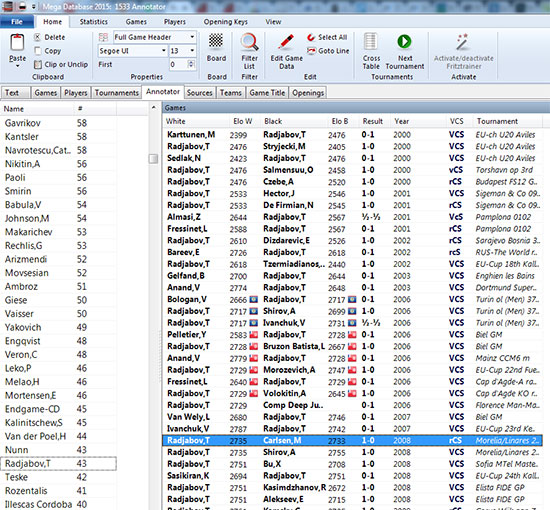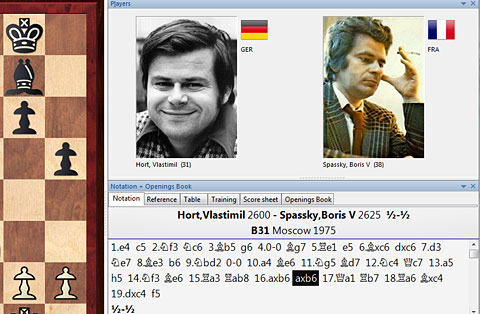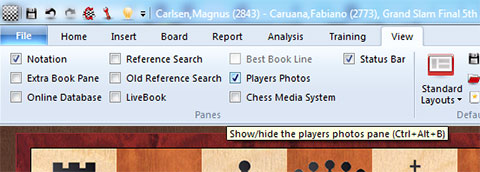
When purchasing a database with the lofty name 'Mega' Database, you expect content that is best described in extremes, and rest assured it lives up to its name and reputation.
- Close to 6.5 million games
- Over 68,500 commented games
- Uses a new Playerbase with nearly 390 thousand player names
- 35 thousand pictures
6,466,288 games games
The number is hard to grasp. After all, even the most devout competitive players will play at most a couple of thousand games in their careers on average, so how do you fit in millions? The fact is that chess has sped up the number of games and material available over the years, thanks to the internet. On average, hundreds of thousands games are being added each year, from modest amateur competitions and chess leagues, to the elite events we all follow and admire throughout the year.
However, not only are the year's games included, but also newly uncovered games found in nearly forgotten chess books, magazines and more. That is how even players long dead such as Alekhine or Botvinnik still see their number of games increase over the years.
68,500 commented games
This number too is hard to get one's head around. After all, even large collections of commented games rarely include more than 100 games in a single hefty volume, and here it is basically saying there are 685 of those hefty volumes.

On the left you can see the list of annotators, listed by order of the most commented games.
On the right is the list of games commented by Radjabov, and whose games they were. For
example, Anand has in excess of 200 self-commented names, Kasparov has nearly 60, etc.
How good and interesting are they? They are all relevant, and it depends. You will find rare masterpieces commented by modern grandmasters, as well as including notes found in sources of the time. That is how you will find snippets from Lasker, comments by Capablanca, and many more, and of course the top players of today.
Each year, ChessBase Magazine publishes games played and commented by the very best players in the world, including Magnus Carlsen, Hikaru Nakamura, Fabiano Caruana, Vishy Anand (whose commented games in Mega number the hundreds), Vladimir Kramnik, and so many more. Each year those commented games are added to the next edition of Mega Database.
Here is a game, chosen fairly randomly (it needed to be a top player), to give you an idea on what to expect:
Teimour Radjabov vs Magnus Carlsen (Linares 2008)
(Annotated by Teimour Radjabov)

[Event "Morelia/Linares 25th"] [Site "Morelia/Linares"] [Date "2008.02.22"] [Round "6"] [White "Radjabov, Teimour"] [Black "Carlsen, Magnus"] [Result "1-0"] [ECO "C65"] [WhiteElo "2735"] [BlackElo "2733"] [Annotator "Radjabov,T"] [PlyCount "85"] [EventDate "2008.02.15"] [EventType "tourn"] [EventRounds "14"] [EventCountry "ESP"] [EventCategory "21"] [Source "ChessBase"] [SourceDate "2008.04.02"] 1. e4 {I started with -1 and was still on this score before my game vs Carlsen. I had ambitions to fight in all games, but I didn't manage to capitalise on my chances before this win finally came.} e5 2. Nf3 Nc6 3. Bb5 Nf6 4. d3 {With this move I scored an important win with this move in a match Azerbaijan-France in the European Team Championship for the bronze medals!} (4. O-O {Of course it's more natural to go 0-0 here, but I was in a mood to try the d3-system.}) 4... Bc5 5. c3 O-O 6. O-O d5 7. Nbd2 {White plays for a very small plus! Black may choose now between many options, like ...Bg4 or ...Re8 etc... Carlsen decided to clarify things in the center by taking on e4.} dxe4 8. Nxe4 (8. dxe4 {also deserves serious attention, but I guess that my intention was to get my c1 bishop to a more active position.}) 8... Nxe4 9. dxe4 Qf6 {Now Black wants to go for ...Ne7-g6 or ...Bg4. White has to take measures, also ...Rd8 is threatening and ...Qg6 to follow etc...} (9... Qxd1 10. Rxd1 $14) 10. Qe2 (10. Qd5 {I didn't like this so much as I felt Black has a lot of play for the pawn! Two bishops and White's uncoordinated queenside are worth that investment.} Bd6 11. Bxc6 bxc6 12. Qxc6 Bg4 $44) 10... Bg4 { Very natural and played almost instantly!} (10... h6 $5 11. Bxc6 (11. Rd1 $6 { Solid but not more! Black is in time to regroup now!} Ne7 12. b4 (12. Be3 Bxe3 13. Qxe3 Bg4 14. Be2 Ng6 15. g3 b6 16. Ne1 $13) 12... Bb6 $13) (11. Be3 Bxe3 12. Qxe3 Ne7 $11) 11... bxc6 12. Be3 $14) 11. h3 {What else? If I allow this pin to last, Black will start to play Ne7-g6-h6 c6, clearly improving his position, meanwhile White has no targets to attack!} Bxf3 (11... Bh5 12. g4 Bg6 13. Bg5 Qe6 14. Rfd1 $16) 12. Qxf3 Qxf3 13. gxf3 Ne7 {Well , very natural} ( 13... f5 {I thought Black could play like this after gxf3, to open the f-line and start Rf6-Raf8 and so on.} 14. b4 {But I think that White is still better after b4 or Bc4+.} (14. Be3 Bxe3 15. fxe3) (14. Bc4+ Kh8 15. Bd5 $14) 14... Bb6 15. Bc4+ Kh8 16. a4 $14) 14. f4 $5 (14. b4 $5 {Well, it was also possible to start with this move! I didn't want somehow to allow Bd6 preventing f4 and probably I was right!} Bd6 $1 {But after this move I am not sure at all that White has something real.} (14... Bb6 15. a4 a5 (15... c6 {Black has to go like this otherwise White is much better!} 16. Bc4 (16. Be2 $5 {Looks very strong too! Now a5 is threatening and Be3 with typical advantage!} a5 17. Rb1 $1 $14 axb4 18. Rxb4 Nc8 19. Rd1 c5 20. Rb5 $16) 16... a5 17. Rd1 (17. Rb1 $6 { The bishop on c4 is hanging!} axb4 18. Rxb4 Nc8 19. Rd1 Bc5 {Here is the difference to the Be2 retreat, the bishop on c4 is hanging!}) 17... Rfd8 18. Be3 $14 (18. Bg5 Kf8 19. Rdb1 $14 (19. Rxd8+ Rxd8 20. Rb1 $5 f6 21. bxa5 Bxa5 22. Be3 b6 23. Rb3 c5 {and Black is in time to block somehow.}))) 16. bxa5 Rxa5 (16... Bc5 17. Rd1 $16) 17. Ba3 c5 18. Rfd1 $16) 15. Be3 a5 16. a3 Ng6 $13) ( 14. Bc4 $5 {looks very interesting. It is better than b4, because now White has no weaknesses on the queenside and he can try to make use of the bishop pair without fearing any kind of fast counterplay.}) 14... c6 (14... Ng6 15. f5 (15. fxe5 c6 16. Ba4 Rad8 {Black is well developed and very active!}) (15. Be3 Bxe3 16. fxe3 $11) 15... Nf4 (15... Nh4 16. Be2 $16) 16. Bxf4 exf4 17. e5 $5 $14 {Here this move looks better for White. The idea is that now White is going to play Rad1 and then Kg2-f3 xf4 and so on.} (17. Rad1 Rfd8 (17... c6 18. Ba4 $14) 18. e5 c6 19. Bc4 f3 20. Bb3 Kf8 $13) (17. Kg2 Rfd8 18. Rad1 (18. e5 c6 19. Bc4 Rd2) 18... g5 $6 (18... f6 19. Kf3 (19. Bd3 $5) 19... Rxd1 20. Rxd1 Bd6 21. Bc4+ Kf8 22. h4 $14 {Better for White, but also hard to progress.}) 19. e5 $1 (19. Kf3 f6 $1 {The best move!} (19... Kf8 20. f6 $16 {This looks quite strong! Now White is much better!} c6 21. Bc4 Bb6 22. Kg4 h6 23. Kh5 Rxd1 24. Rxd1 Rd8 25. Rxd8+ Bxd8 26. e5 Bb6 27. f3 $16) (19... c6 20. Ba4 h6 21. f6 $14) 20. h4 h6 21. Bd7 (21. e5 fxe5 22. Rde1 Be7 $11) 21... Kg7 22. Rg1 Bd6 23. Be6 a5 24. a4 {But still, it's hard to make any progress!}) 19... c6 20. Bc4 b5 21. Be2 $16) 17... Rfd8 18. Rad1 $14) 15. Bc4 exf4 16. Bxf4 Ng6 17. Bg3 Rfe8 { All the moves from both sides are logical. Both are developing their forces.} 18. Rfe1 (18. Bd3 {deserved attention! Well, now White wants to go for Rad1 and Kg2 with f4-e5, with slight and unpleasant pressure.} Rad8 (18... h5 19. Rad1 h4 20. Bh2 Ne5 21. Be2 $14) 19. Rad1 $14 Ne5 (19... Bd6 20. f4 {and White is pressing!}) 20. Be2 $14) 18... Rad8 19. Rad1 $1 {Even if objectively White is not better according to the computer's analysis, practically speaking it was the best. Now White's play is quite easy and Black has to find defences which are not all that easy.} Rxd1 20. Rxd1 Rxe4 {Carlsen thought for a long time here, but finally took the pawn. I think it was the right decision if Black could manage to find all the best moves afterwards.} 21. Rd8+ Nf8 (21... Bf8 $6 {is a mistake I think. The bishop and knight are too passive now, White gets a strong attack and all Black's pawns are very very weak without the bishop's protection!} 22. Bd3 Re6 (22... Re1+ 23. Kg2 Rd1 $4 24. Kf3 $18) 23. Ra8 $16) 22. Bd3 Re1+ 23. Kg2 a5 (23... g6 $6 24. b4 Bb6 25. Rb8 Re7 (25... Rd1 26. Be4 Rd7 27. a4 f5 28. Bf3) 26. a4 Rd7 27. Be4 $14 (27. Be2 Bd8 28. b5 Ba5 29. c4 cxb5 30. axb5 Bb4 31. Bf3 b6 32. Ra8 $14 {White keeps up unpleasant pressure on Black's position, combining attacks on the pawns with bishop manoeuvres all over the board.})) 24. Ra8 Rd1 25. Bc4 (25. Be4 {was an interesting alternative! Probably even stronger than the text. My intention was to put the bishop on c4 attacking f7, but maybe the bishop is better placed on e4 as the c6-b7 pawns are vulnerable and the b-pawn can't move to protect a5! Also Bf3 at some tpoint to combine ideas like pushing the a- and b-pawns and putting pressure on c6; the bishop is well placed on f3 to support White's play on the queenside.} g6 $8 {Black has to get rid of the pin! Otherwise it's hard to play vs two bishops and an active rook on a8.} 26. Rxa5 Ne6 (26... Bd6 $6 27. Ra7 $5 (27. Bf3 Rd2 28. Bxd6 Rxd6 29. Ra7 $1 {Now Black is in trouble! a4-b4 is coming and the bishop provides support from f3.}) 27... Bxg3 28. Kxg3 Rd7 29. a4 $16) 27. a4 Kg7 28. b4 Bd6 29. Bxd6 Rxd6 30. Ra7 $14) 25... Bb6 $2 {Now Carlsen misses White's strong reply. I was not sure if the position is winning after it, but it was clear that White is simply much better.} (25... b6 $1 26. a3 {To play b4 and try to attack the b6- and c6-pawns!} Ra1 $3 27. Ra7 (27. Rc8 a4 $1 28. Rxc6 Rb1 29. Rc7 Ne6 {and it's draw finally.} 30. Rc8+ Nf8 $11) 27... Ne6 28. Ra8+ Nf8 29. h4 g6 30. Bf4 h5 $14 {It's unpleasant to play this position as Black, but it's also hard to make any progress with White. Still practically speaking White's position looks preferable to me.}) 26. Rb8 $1 Rd7 27. Ba6 $1 {Now the b7-pawn is going be taken, Black can't allow this. Carlsen goes for the best defensive chance.} bxa6 (27... Bc7 {In this case Black ends in a hopeless endgame. After this move Black is totally lost, but I can't put in 20-25 moves variations to prove that assesment, so I will just put it down as a big advantage for White. I will explain how White wins in this way. He is going for Bxc7 and then Rxb7, he will bring the king to the queenside, exchanging all pawns leaving only the a-pawn vs the knight. Then his opponent should normally resign at some point. But ok, if it didn't happen, so don't blame me :)} 28. Bxc7 (28. Rxb7 Bxg3 29. Kxg3 $16) 28... Rxc7 29. Rxb7 Rxb7 30. Bxb7 c5 31. Kf3 Nd7 32. Ke4 Nb6 33. Bc6 $16) 28. Rxb6 f6 (28... f5 $6 {looks interesting, with a possible Ng6-f4 later. But there is a trick that White can try.} 29. Rxc6 $5 (29. Rxa6 $5 Ng6 { f4 is coming on the next move, but...} 30. h4 f4 31. h5 fxg3 32. hxg6 hxg6 33. Kxg3 Rd2 34. b4 (34. Rxa5) 34... Rd3+ 35. f3 Rxc3 36. Rxa5 $16) 29... Rd2 ( 29... Ng6 30. Bd6 $18) 30. Rxa6 Ng6 31. h4 f4 32. h5 fxg3 33. hxg6 hxg6 34. Kxg3 $16) 29. Rxa6 (29. Rxc6 $5 {was very strong I think.} Rd2 30. Rxa6 Rxb2 31. Rxa5 g5 32. a4 $16 {and in this position it's very hard for Black to keep up his defence. White's a-pawn is too strong.}) 29... Rd2 {Now Black is not even a pawn down. So he has good chances to hold the game, it seems. But in practice his task was very hard, I think.} 30. b4 axb4 (30... Rxa2 31. Rxa5 Re2 32. Ra6 Re6 33. c4 {and White is much better here. He has a lot of pressure and it is hard to defend with Black.} Kf7 34. b5 cxb5 35. cxb5 Re1 36. Ra7+ Ke6 (36... Kg6 37. Bd6 Ne6 38. b6 $18) 37. Rxg7 Rb1 38. Rb7 $16) 31. cxb4 Rb2 $6 ( 31... Ng6 $1 {with the idea f5-f4 somewhere.} 32. a4 (32. Rxc6 Rxa2 33. b5 Rb2 $14) 32... Ne7 (32... f5 {is not useful here as White may go for Bc7 or Bb8 and weakening of the e5 -square is not in Black's plans.} 33. Bb8 $16) 33. a5 $5 (33. Ra7 Nf5 34. a5 Ra2 35. Ra6 Ra4 36. Rxc6 (36. Rb6 Nxg3 37. fxg3 c5 38. bxc5 Rxa5 39. c6 Rc5 40. Kf3 Rc4 $11) 36... Rxb4 37. a6 Ra4 38. Bb8 $14) 33... Kf7 34. Bf4 Rc2 (34... Rd4 35. Be3 Rxb4 36. Ra7 $1 $18) 35. Bd6 Nd5 36. Ra8 Ke6 37. Bc5 $16 {und White has good chances to win the game as the position is quite similiar to the game and hardly savable for Black.}) (31... f5 32. a4 $16 ) 32. Bd6 Ne6 $6 (32... Ng6 33. a4 $16 Rc2 34. a5 Kf7 35. Bc5 Nf4+ 36. Kf3 Nd5 37. Rxc6 $18) 33. a4 $18 Rc2 34. a5 (34. Ra8+ Kf7 35. Rc8 {was even cleaner!}) 34... Kf7 35. Bc5 $5 (35. Rb6 $18) 35... Nf4+ 36. Kf3 Nd5 (36... Nd3 37. Ke3 $1 Nxc5 38. Rxc6 $18) 37. Rb6 $1 {() After this move White is totally winning.} ( 37. Rxc6 $18) 37... Rc4 (37... Kg6 38. a6 Rc3+ 39. Ke2 $18) 38. Rb7+ $18 Kg6 39. a6 Rc3+ 40. Kg2 $5 (40. Ke2 Nf4+ (40... Ra3 41. a7 Nc3+ 42. Kd3 Nb5+ 43. Kc2 h5 44. Kb2 Ra4 45. Rb8 $18) 41. Kd2 Ra3 42. a7 $18) 40... Nf4+ 41. Kg1 { And the last important move.} ({It was still possible to spoil everything by} 41. Kh2 Rxh3+ 42. Kg1 Ne2+ 43. Kf1 Nf4 $11) 41... Nxh3+ 42. Kh2 Nf4 43. Be3 { After this move Carlsen resigned.} (43. a7 Rh3+ 44. Kg1 Ne2+ 45. Kf1 Nf4 46. Ke1 Nd3+ (46... Ra3 47. Kd2 $18) 47. Kd2 Nxc5 48. a8=Q Nxb7 49. Qxb7 Rh4 50. Kc3 {and White wins the c6-pawn and the game.}) 1-0
35 thousand pictures
This is more than a gimmick, this is a luxury, and a record of a player's career. Take Boris Spassky for example, a player with a long career, and Vlastimil Hort, another fixture of the second half of the 20th century.

Pulling up a game from 1962 between the two from the world U26 championship
shows a very young Hort, aged 18 (note the ages in parentheses) and Spassky
who is 25. Suppose we roll the clock forward to... 1975.

Now we see an adult Hort, 31 years old (again, note the age in parentheses)
facing a 38-year-old Boris Spassky. The pictures have changed to reflect this.

Finally we leap forward in time to 1999 where we have a graying Hort, 55, and
Spassky, silver haired and 62
Certainly the pictures cannot be considered essential to studying, but putting a face to the player is certainly pleasant, and reminds us there was a person behind those moves, struggling and competing. In fact, even when there are no photos to go by, such as the great Philidor, images depicting him are used instead.

If you own Mega 2016, or a previous edition, and do not see the player photos,
open a game from Mega and in the View tab put a check in Players Photos
A year of updates
When evaluating the price of Mega Database, it bears mentioning that included in the package is a subscription to the ChessBase update system. This alone is a 49 Euro value in and of itself. In a nutshell, using ChessBase program, you receive a serial number that allows you to update the database with the latest games of the week, thousands of games, and all with the same standard of names of players and events. Anyone who recalls the databases years back with half a dozen Korchnois, all with different spellings, to cite but one example, can appreciate the importance of this.
This subscription not only will start as of the week Mega was finalized, meaning you will not miss games played in November and December 2015, but will continue throughout the entire year of 2016.
Available in the ChessBase Shop






























